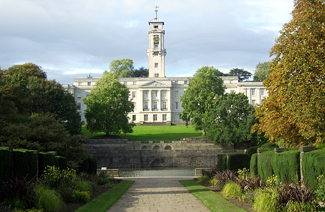第一篇:远古鱼是怎么进化成陆地动物的
2012.9.2ML 海洋生物的进化
2. 还有一篇讲的是远古海里生物、鱼怎么上岸的。说是最开始的鱼都在海里,
后来好多地儿只要是aquatic 的地儿都有鱼,特别是一种鱼record 最多,有图。
后来又说鱼不光有gill 还有lung 辅助呼吸,这样在干旱的时候他们能从要没水
的地儿到水很多的地儿(呃,好像是这样,有题)
然后干旱啊,水都少了,河边上都是死鱼,in addition 水生植物也都出来了,
螃蟹也上岸了(有题)
后来又说到牙齿,food 什么的(有题,我选的是carnivo),又说虽然上岸了,还
是不离水太远(好像是,有题,是个选项)。最后说鱼就通过骨骼生长就岸了(考最
后一句,扩折号举例)
不全,有几段忘了,呵呵呵
词汇:
aquatic 水生的
record 记录
gill 鳃
lung 肺
respiration 呼吸
in addition 另外
crab 螃蟹
carnivore 食肉动物
背景复原:
Evolution of fish:
Fish first appeared during the Cambrian explosion, around 530 million years ago (Ma). Early fish from the fossil record are represented by a group of small, jawless, armoured fish known as ostracoderms. Jawless fish lineages are mostly extinct. An extant clade, the lampreys may approximate ancient pre-jawed fish. The first jaws are found in Placoderm fossils. The diversity of jawed vertebrates may indicate the evolutionary advantage of a jawed mouth. It is unclear if the advantage of a hinged jaw is greater biting force, improved respiration, or a combination of factors. The first animals to venture onto dry land were arthropods. Some fish had lungs and strong, bony fins and could crawl onto the land also.
Age of Fishes
The Devonian, part of the Paleozoic era, is otherwise known as the Age of Fishes, as it spawned a remarkable variety of fish. The most formidable of them were the armored placoderms, a group that first appeared during the Silurian with powerful jaws lined with bladelike plates that acted as teeth. Early placoderms fed on mollusks and other invertebrates, but later species developed into ferocious, fish-slicing monsters measuring up to 33 feet (10 meters) long. Other types of bone-plated fish that lacked jaws developed a range of bizarre forms. Fossil specimens include species with horseshoe-shaped heads and others that looked like rounded shields.
From Water to Land
One important idea in evolution is that creatures from the oceans slowly evolved to live and walk on land. Fish have different muscles and bone structure than land animals, so the evolution of fish would have required the change of many different kinds of body parts. One way scientists examine these evolutionary changes is by looking at fossils, like the dinosaurs you see in museums. Fossils are an ancient record of creatures that lived on earth hundreds of thousands of years ago. But most fossils are only the hardened skeletons of creatures. Because muscles and other softer parts of animals do not usually become fossils, scientists run into problems when trying to learn about muscle evolution. Instead of looking at fossils, they have to use creative ways to figure out muscle evolution.
Knightia
This is a little fish from the Eocene that is represented by literally thousands of specimens, and is why it is one of the most common fossils offered to collectors. Knightia is a good example of how seemingly small and unimportant fish can make up a very important part of an ecosystem and provide much of the biomass that other animals feed upon.
Lungfish
The lungfish, together with the Coelacanth, are the closest living relative of land vertebrates. They breathe through lungs like our lungs and can survive in brackish water with low oxygen content due to this. When their water dries up lungfish can remain dormant in burrows breathing air for years.
Palaeozoic fish
Before the fish evolved to become amphibians there were plants and invertebrates on land but nothing needed to evolve defenses against vertebrate methods of feeding. Therefore it is likely any fish that could survive in brackish water, in shallow water or on land even for a short time could get plenty of food that was easy to take. This could apply to carnivores or herbivores and could have been a factor in fish evolving to live on land.
第二篇:欧洲1400-1500年间经济蓬勃发展的原因
版本一:就说城市人口多了,需要买更多东西,于是人们的income增加。然后政府也在主动促进某些产业发展。然后因为有migrant,很多资金和商品开始流动。很多只在本地销售的商品在别处出现了,商品销售量提高
运输的成本也降低了因为运输货物比之前更安全。最后因为技术进步,产品成本降低了,比如挖矿的时候可以利用本来没用的矿
版本二:欧洲industrial 贸易什么的。移民人口增多,需求增大,各种促进。然后技术革新,cost降低,transportation 也更新。
The industrial revolution in Europe-something on how the “determinants” of the industrial rev in Europe. Also mention something about the printing.
背景复原:
The Commercial Revolution was a period of European economic expansion, colonialism, and mercantilism which lasted from approximately the 13th century until the early 18th century. It was succeeded in the mid-18th century by the Industrial Revolution. Beginning with the Crusades, Europeans rediscovered spices, silks, and other commodities rare in Europe. This development created a new desire for trade, and trade expanded in the second half of the middle Ages. European nations, through voyages of discovery, were looking for new trade routes in the 15th and 16th centuries, which allowed the European powers to build vast, new international trade networks. Nations also sought new sources of wealth. To deal with this new-found wealth, new economic theories and practices were created. Because of competing national interest, nations had the desire for increased world power through their colonial empires. The Commercial Revolution is marked by an increase in general commerce, and in the growth of financial services such as banking, insurance, and investing.
A combination of factors drove the Age of Discovery. Among these were geopolitical, monetary, and technological factors. The Europeans involved in the Age of Discovery were mainly from Britain, France, the Netherlands, Spain, and Portugal. During this period (1450-17th century), the European economic center shifted from the Islamic Mediterranean to Western Europe (Portugal, Spain, France, the Netherlands, and to some extent England). This shift was caused by the successful circumnavigation of Africa opening up sea-trade with the east: after Portugal's Vasco da Gama rounded the Cape of Good Hope and landed in Calicut, India in May 1498, a new path of eastern trade was possible ending the monopoly of the Ottoman Turks and their European allies, the Italian city-states.[6] The wealth of the Indies was now open for the Europeans to explore; the Portuguese Empire was one of the early European empires to grow from spice trade.[6] Following this, Portugal became the controlling state for trade between east and west, followed later by the Dutch city of Antwerp. Direct maritime trade between Europe and China started in the 16th century, after the Portuguese established the settlement of Goa, India in December 1510, and thereafter that of Macau in southern China in 1557. Since the English came late to the transatlantic trade, their commercial revolution was later as well.
第三篇:Anasazi人灭绝的原因是过度开发自然资源
背景复原:
Anasazi
Ancient Pueblo peoples or Ancestral Pueblo peoples were an ancient Native American culture centered on the present-day Four Corners area of the United States, comprising southern Utah, northeastern Arizona, northern New Mexico, and southwestern Colorado. They lived in a range of structures, including pit houses, pueblos, and cliff dwellings designed so that they could lift entry ladders during enemy attacks, which provided security. Archaeologists referred to one of these cultural groups as the Anasazi, although the term is not preferred by contemporary Pueblo peoples.[2]
The word Anaasází is Navajo for "Ancient Ones" or "Ancient Enemy".[3] Archaeologists still debate when this distinct culture emerged. The current consensus, based on terminology defined by the Pecos Classification, suggests their emergence around the 12th century BCE, during the archaeologically designated Early Basketmaker II Era. Beginning with the earliest explorations and excavations, researchers wrote that the Ancient Puebloans are ancestors of contemporary Pueblo peoples.
The Disappearance of the Anasazi
Diamond believes that communities need to maintain self-sufficiency in order not to collapse. He contends that when societies become dependent upon importing their needed resources, they become more vulnerable to collapse.
His thesis is that Chaco Canyon was abandoned because of BOTH the human impact on the environment and because of drought. The drought was the last straw or “proximate” cause of collapse for a society that had become overpopulated for the amount of resources it had to maintain self-sufficiency. With the increase in population due to their success at managing water and goods and developing an intricate and complex society, the society starved when drought became severe, and they had no other resources to draw upon since they had ruined the soil, deforested the region, and were dependent upon “outliers” who probably revolted to support them.
The collapse of the Anasazi communities illustrates the theme of human environmental impact and climate change intersecting, environmental and population problems spilling over into warfare, the strengths but also the dangers of complex non-self –sufficient societies dependent on imports and exports, and societies collapsing swiftly after attaining peak population numbers and power.

















